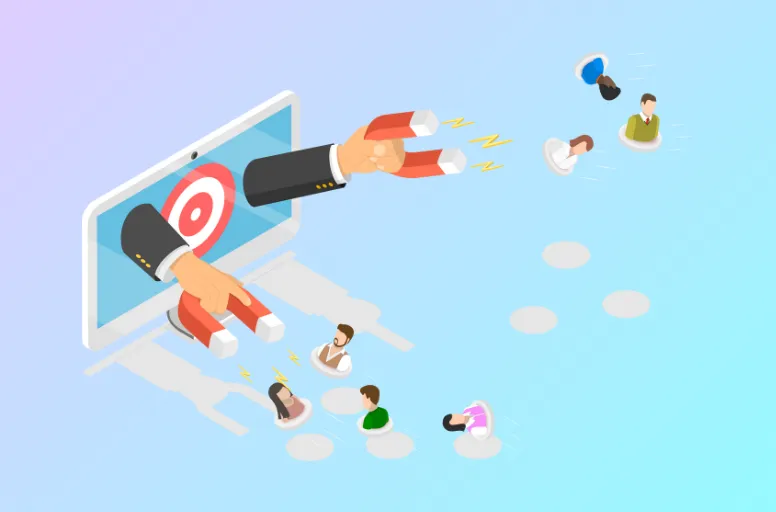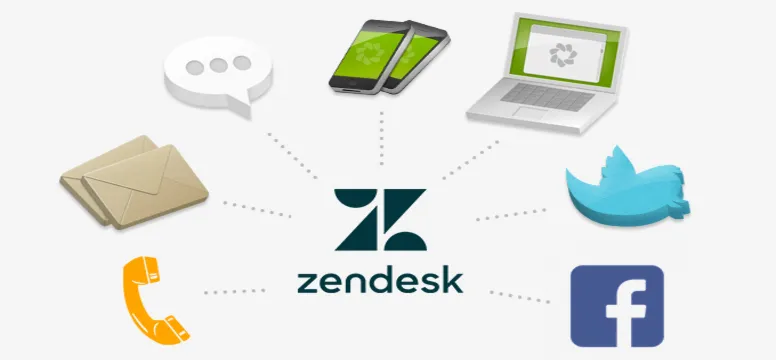An omnichannel customer service is a unified approach to customer support that allows customers to interact with a business seamlessly across multiple channels—such as phone, SMS, email, social media chat, chatbot, and in-person. It ensures consistent communication and service quality, regardless of the platform the customer uses.
For instance, a customer might start by using a chatbot for support. If the issue requires more time to resolve, they could opt to get a response via email. Alternatively, they might be connected to a live agent through chat or phone.
The agent would already have all the necessary details, so the customer wouldn’t need to explain the situation again.
So how to implement omnichannel customer service in your business? Keep reading to learn more about:
- The differences between multichannel vs omnichannel customer service
- Benefits of omnichannel customer service
- How to create a competitive omnichannel customer service strategy
- Omnichannel customer service examples & case studies
Let’s dive in!
The Differences Between Multichannel vs Omnichannel Customer Service
Both omnichannel and multichannel customer service involve providing support through various communication channels such as phone, email, chat, and social media.
They share the goal of enhancing customer satisfaction by offering customers the flexibility to choose their preferred method of communication.
However, there are some major differences that we outline in the table below:
Aspect | Multichannel | Omnichannel |
Definition | Multiple, separate customer service channels (e.g., phone, email, social media) that do not interact with each other. | Unified customer service experience where all channels are integrated and connected. |
Focus | Offering customers several channels to choose from, each operating independently. | Creating a seamless and consistent experience across all channels by integrating them. |
Goal | Maximize presence on various channels to provide options for customers. | Ensure consistency and continuity, enabling customers to move smoothly between channels. |
Customer experience | Fragmented experience where customers may need to repeat information when switching between channels. | Seamless experience, where interactions are continuous and personalized regardless of the channel used. |
Data integration | Data is collected separately for each channel, resulting in siloed information. | Centralized customer data that is accessible across all channels for personalized interactions. |
Marketing and promotions | Marketing messages and promotions may vary by channel, leading to fragmented messaging. | Consistent marketing messages and promotions across all channels, tailored based on customer behavior. |
Benefits of Omnichannel Customer Service
1. Enhanced customer experience and loyalty

Omnichannel customer service ensures that customers can interact with a brand seamlessly across multiple channels, whether it be via social media, phone, email, or in-store.
This unified approach creates a more consistent and satisfying customer experience, as customers can switch between channels without repeating themselves or encountering fragmented information.
When customers feel valued and understood, their satisfaction and loyalty naturally increase.
They are more likely to return and engage with the brand, fostering long-term relationships that are essential for sustained business success. The result is a stronger emotional connection, leading to brand advocacy.
2. Increased sales and revenue growth
By employing an omnichannel customer support system, businesses can meet customers wherever they are, streamlining the buying process and reducing friction.
Customers who receive consistent customer service across channels are more likely to complete their purchases, leading to higher conversion rates.
Additionally, omnichannel strategies often reveal valuable insights into customer behavior, allowing companies to customize marketing efforts and product offerings more effectively.
This targeted approach not only boosts initial sales but also encourages repeat purchases.
Over time, these enhanced interactions contribute to substantial revenue growth and a healthier bottom line.
3. Faster support and improved response time

An omnichannel approach integrates all customer service platforms, enabling representatives to access comprehensive customer data quickly, regardless of the channel the customer chooses.
This integration significantly reduces response times, as service agents can resolve issues more efficiently by having all the necessary information at their fingertips.
Customers benefit from faster, more accurate support, which enhances their overall experience.
Speedy, effective resolutions reduce customer frustration and prevent potential escalations, fostering a sense of trust in the brand’s ability to meet their needs promptly.
This efficiency is crucial in a fast-paced market where time is of the essence.
4. Personalized customer interaction
Omnichannel customer service allows businesses to collect and analyze data from various touchpoints, enabling a deeper understanding of individual customer preferences and behaviors.
The information allows companies to personalize interactions and offers to each customer.
Personalized interactions, for example, can be product recommendations or targeted promotions, all designed to meet the customer’s specific needs.
Such attention to detail not only makes customers feel valued but also increases their likelihood of making a purchase, thus driving both customer satisfaction and business growth.
5. Greater customer retention and reduced churn

A consistent and personalized customer experience across all channels helps build trust and satisfaction, which are key drivers of customer retention.
When customers receive a high level of service and feel understood by a brand, they are less likely to switch to competitors.
Omnichannel customer support ensures that customers can easily resolve issues and have their needs met, reducing the chances of frustration and dissatisfaction, which often lead to churn.
By addressing customer concerns effectively and maintaining positive engagement, businesses can significantly improve retention rates and reduce the costs of acquiring new customers.
6. Lower operational costs and increased agility
Implementing an omnichannel customer service strategy can lead to significant cost savings by streamlining operations and improving efficiency.
By integrating all communication channels into a single platform, businesses can reduce the need for multiple service teams or redundant systems. Thereby, they can cut down on operational expenses.
Additionally, the improved efficiency allows for quicker responses to customer inquiries, reducing the workload on customer service agents.
This streamlined approach lowers costs and increases the company’s agility. It enables businesses to adapt quickly to changing customer needs and market conditions, ultimately supporting sustained growth.
How to Create a Competitive Omnichannel Customer Service Strategy
1. Understand and map the customer journey

Creating a competitive omnichannel customer service strategy begins with deeply understanding your customer’s journey.
Start by mapping out every touchpoint where customers interact with your brand, from initial contact to post-purchase support. Identify the channels they prefer, their challenges, and their expectations at each stage.
This map will help you visualize the entire customer experience, revealing gaps and opportunities for improvement.
To provide top-notch service, incorporate feedback systems encouraging customers to share their experiences regularly. This input will help you refine and improve your omnichannel strategy.
2. Identify and optimize channel usage
Once you have a clear picture of the customer journey, the next step is to identify which channels are most critical to your customers and optimize their usage. Not all channels will be equally important; some may require more resources than others.
According to Statista, email and call are the most popular channels, followed by contact form and chat.
As you can see, customers will reach out in various ways and expect to receive responses via multiple channels.
Therefore, businesses should analyze customer behavior to determine where they spend the most time and which channels they use for specific tasks, such as browsing, purchasing, or seeking support.
Focus on optimizing these key channels to ensure smooth, efficient omnichannel communication for customer service. Regularly review and adjust your channel strategy to keep pace with changing customer preferences.
3. Make use of technology for efficiency
The right technology plays a key role in an effective omnichannel customer service. If you are unsure which software and tool to choose, let’s search for Communications Platform as a Service (CPaaS).
It integrates communication tools with cloud technology, funneling all customer interaction data through a single system and offering critical insights into customer needs.
By connecting CPaaS with your customer relationship management (CRM) systems, call center, and other data systems, you can:
- Enable real-time communication in your apps and websites
- Streamline processes across various channels
- Facilitate efficient case routing and personalized customer interactions
Moreover, CPaaS can assist in adding a conversational AI chatbot to your customer service, catering to the growing preference for self-service and cutting costs.
4. Offer robust self-service options

Incorporating self-service options into your omnichannel strategy is essential for meeting customer expectations in today’s digital age. Many customers prefer to resolve issues independently, without needing to contact a service representative.
Develop a comprehensive self-service portal with FAQs, troubleshooting guides, video tutorials, and chatbots. Ensure these resources are easily accessible and provide clear, concise information.
A well-designed self-service platform not only improves customer satisfaction by providing instant solutions but also reduces the volume of inquiries that your support team needs to handle, further increasing operational efficiency.
5. Prioritize data security and privacy
As you integrate various channels and technologies, there is a concern about data security and privacy.
Customers need to trust that their personal information is safe when interacting with your brand. Implement robust security measures, such as encryption, multi-factor authentication, and regular audits, to protect sensitive data across all platforms.
Additionally, ensure compliance with relevant data protection regulations, like GDPR or CCPA, depending on your geographic location. Transparent communication about how you handle and protect customer data will build trust and confidence.
That is crucial for maintaining long-term relationships in an omnichannel customer service environment.
6. Upskill your team
Your omnichannel strategy’s success also depends on your team’s skills and knowledge. You can invest in ongoing training to ensure that your customer service representatives are proficient in using the latest technologies and understand the nuances of each channel.
Training should cover technical skills and soft skills like communication, empathy, and problem-solving, which are essential for delivering exceptional customer service.
Encourage a culture of continuous learning and adaptability so your team can quickly adapt to new challenges and changes in customer behavior.
Omnichannel Customer Service Examples & Case Studies
The benefits of an omnichannel experience are clearer than ever. As more customers engage online, businesses need additional digital channels to connect with them. If your business is still operating in silos, take note of how these companies achieved significant success by adopting an omnichannel strategy.
1. Casper

Casper is an online brand specializing in sleep products, seamlessly integrating its website, mobile app, customer service team (Sleep Specialists), and physical stores (Casper Sleep Shops) to create a unified shopping experience across all channels.
This brand offers seamless omnichannel communication for customer service, where customers can shop for mattresses online or visit physical stores to try them out. They can also take advantage of a 100-night trial with easy returns.
If they have any questions, Casper’s sales team is available via phone, email, or website chat. Additionally, the Casper mobile app provides extra features like sleep tracking, integration with health apps, and personalized sleep tips.
2. Zendesk

You can’t talk about omnichannel customer experiences without highlighting Zendesk. As a top provider of omnichannel customer support, Zendesk offers a variety of support channels, including email, live chat, phone, social media, and self-service portals.
With Zendesk, customer interactions from different channels are tracked and made available to support agents in a single, unified interface. This allows for a seamless transition when a customer moves from one channel to another, like going from live chat to a phone call, without losing context.
Zendesk also employs AI-powered chatbots to provide quick responses and solutions across multiple channels.
3. Blue Apron

Blue Apron, a US-based meal kit company, has taken its omnichannel customer service to the next level by seamlessly integrating its website, mobile app, and email strategies with an expanding presence in physical stores.
Through its website and mobile app, Blue Apron enables customers to easily customize their meal plans, access a wide range of recipes, and track their deliveries across all channels.
Additionally, Blue Apron provides a comprehensive resource center on both its website and app, featuring FAQs, tooltips, and guides for self-service options. They also offer personalized emails to further enhance the customer experience by recommending recipes based on past purchases and customer preferences.
The company’s omnichannel strategy is further strengthened by its active presence on social media and its robust customer support, which is available through multiple channels, including phone, email, and live chat.
Omnichannel for Customer Service – FAQs
To get omnichannel customer service, businesses need a unified platform that integrates all communication channels. They should also train their employees to provide consistent service across channels and use customer data to personalize interactions. An example of omnichannel customer support is when a company provides seamless customer service across various channels, allowing customers to switch between them without losing context or having to repeat themselves. For instance, if a customer starts a conversation with a company’s support team through live chat on the website but later decides to call the support center, the agent on the phone would already have access to the previous chat conversation. This continuity ensures a smooth and efficient customer experience. An omnichannel customer service tool is a software platform that helps businesses manage customer interactions across multiple channels. It often includes features like live chat, email support, phone support, and social media integration. Omnichannel customer service, while offering numerous benefits, also presents several challenges about
Differentiate Your Brand with Omnichannel Customer Support
If you want to differentiate your brand from others, omnichannel customer service is key. By providing seamless and consistent support across multiple channels—whether through chat, email, phone, or social media—you create a more personalized and efficient experience for your customers. This way not only enhances customer satisfaction but also builds loyalty, helping your brand to stand out and keep growing in today’s dynamic business environment.
For more helpful guides on omnichannel strategy, you have a look at our eCommerce Blog. If you need instant support, don’t hesitate to contact us!



